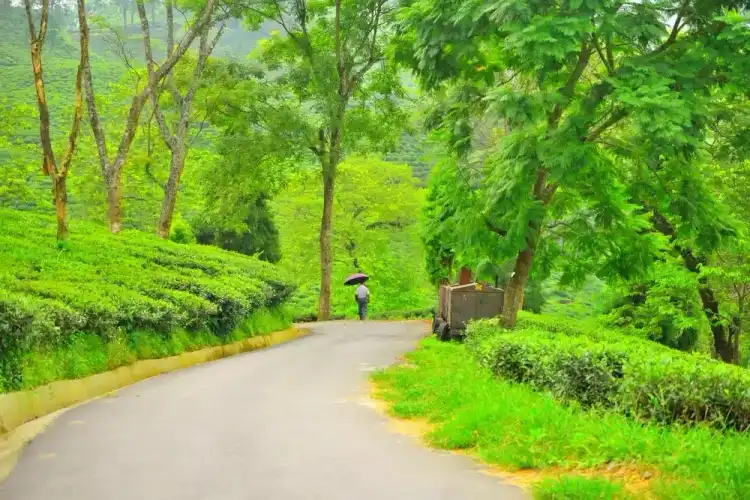Darjeeling: A Comprehensive Guide to the Queen of the Hills
Introduction
Darjeeling, often referred to as the "Queen of the Hills," is a mesmerizing district in the Indian state of West Bengal. Known for its breathtaking landscapes, sprawling tea gardens, and vibrant cultural heritage, Darjeeling attracts tourists from all corners of the globe. This article delves into the rich tapestry of Darjeeling, covering its demography, culture, geography, cuisines, history, notable authors, and administration.
Geography of Darjeeling
Nestled in the Lesser Himalayas at an elevation of 6,700 feet, Darjeeling boasts stunning views of the world's third-highest mountain, Kanchenjunga. The district is bordered by Sikkim to the north, Nepal to the west, and Bhutan to the east. Darjeeling's topography is characterized by its rolling hills, deep valleys, and lush green tea plantations. The region experiences a temperate climate, with cool summers, heavy monsoons, and cold winters, making it a year-round destination.
Climate
Darjeeling enjoys a moderate climate with distinct seasons:
- Summer (April to June): Pleasant with temperatures ranging from 10°C to 20°C.
- Monsoon (July to September): Heavy rainfall and landslides are common.
- Autumn (October to November): Clear skies and mild temperatures.
- Winter (December to February): Cold with temperatures dropping to as low as -2°C.
Demography
Darjeeling has a diverse population of approximately 1.8 million people. The primary ethnic groups include Nepalis, Tibetans, Bengalis, and indigenous Lepchas and Bhutias. The predominant languages spoken are Nepali, Bengali, Hindi, and English, reflecting the multicultural fabric of the region.
Population Distribution
The district is divided into several subdivisions, each with its own unique characteristics:
- Darjeeling Sadar: The main urban area and administrative center.
- Kalimpong: Known for its educational institutions and horticulture.
- Kurseong: Famous for its lush tea gardens.
- Mirik: A serene town centered around the Mirik Lake.
Cultural Heritage
Darjeeling's cultural landscape is a blend of traditions from various communities. Festivals, music, dance, and religious practices all contribute to the vibrant cultural scene.
Festivals
- Dasain and Tihar: Major Hindu festivals celebrated with great fervor.
- Buddha Jayanti: A significant event for the Buddhist community.
- Durga Puja: Celebrated by Bengalis with elaborate rituals and decorations.
- Christmas and New Year: Marked by the Christian population with joy and festivity.
Traditional Music and Dance
The region's folk music and dance reflect its diverse cultural influences. Traditional instruments like the Madal, Dhol, and Sarangi are commonly used. Popular dances include:
- Maruni: A traditional Nepali dance.
- Chabrung: A Lepcha dance performed during festivals.
- Tamang Selo: A rhythmic dance of the Tamang community.
Cuisine
Darjeeling's culinary scene is as diverse as its population. The local cuisine is a delightful mix of flavors from Nepali, Tibetan, Bengali, and Indian influences.
Popular Dishes
- Momos: Steamed dumplings filled with meat or vegetables.
- Thukpa: A hearty noodle soup.
- Churpee: A traditional cheese made from yak's milk.
- Gundruk: Fermented leafy greens.
- Sel Roti: A sweet, ring-shaped rice bread.
Tea
Darjeeling is synonymous with tea. The region's tea estates produce some of the world's finest black, green, white, and oolong teas. The unique climatic conditions and rich soil contribute to the distinctive flavor and aroma of Darjeeling tea, often referred to as the "Champagne of Teas."
History
Darjeeling's history is a tapestry of various cultural and political influences. Originally inhabited by the indigenous Lepchas, the region was later annexed by the Kingdom of Sikkim. In the early 19th century, the British East India Company recognized Darjeeling's strategic importance and developed it as a hill station and a center for tea cultivation.
Colonial Era
The British played a pivotal role in shaping modern Darjeeling. The introduction of tea plantations in the mid-19th century transformed the region's economy and landscape. Colonial architecture, including schools, churches, and bungalows, still dot the hills, offering a glimpse into the past.
Post-Independence
After India gained independence in 1947, Darjeeling became part of West Bengal. The district has witnessed several movements advocating for greater autonomy and recognition of its unique cultural identity, most notably the Gorkhaland movement.
Notable Authors and Poets
Darjeeling has inspired many writers and poets, both local and international. The serene environment and picturesque landscapes have provided a fertile ground for literary creativity.
Laxmi Prasad Devkota
A renowned Nepali poet, Devkota spent part of his life in Darjeeling. His works, including the epic poem "Muna Madan," reflect the socio-cultural milieu of the region.
Mahasweta Devi
An eminent Bengali writer and social activist, Mahasweta Devi's works often highlighted the struggles of the tribal communities in and around Darjeeling.
Administration
Darjeeling district is governed by a decentralized administrative structure, ensuring efficient governance and development.
Administrative Divisions
The district is divided into four subdivisions, each overseen by a Sub-Divisional Officer (SDO):
- Darjeeling Sadar
- Kalimpong
- Kurseong
- Mirik
Local Governance
Local governance in Darjeeling is facilitated by the Darjeeling Gorkha Hill Council (DGHC), established in 1988. The council oversees local administration, development projects, and cultural preservation.
Conclusion
Darjeeling is a land of enchanting beauty, rich cultural heritage, and historical significance. Its diverse population, unique cuisine, and serene landscapes make it a must-visit destination. Whether you are a nature lover, a history enthusiast, or a cultural explorer, Darjeeling offers a multifaceted experience that is sure to leave an indelible mark on your heart.
Explore Darjeeling and immerse yourself in its natural beauty, cultural richness, and historical depth. This enchanting district promises a journey of discovery and wonder.
